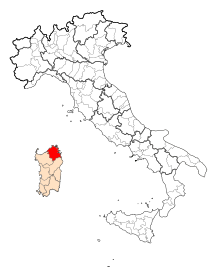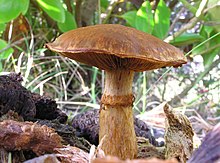Gymnopilus maritimus
| Gymnopilus maritimus | |
|---|---|
| Scientific classification | |
| Domain: | Eukaryota |
| Kingdom: | Fungi |
| Division: | Basidiomycota |
| Class: | Agaricomycetes |
| Order: | Agaricales |
| Family: | Hymenogastraceae |
| Genus: | Gymnopilus |
| Species: | G. maritimus
|
| Binomial name | |
| Gymnopilus maritimus | |

| |
| Gymnopilus maritimus is known only from a localised area in the Province of Olbia-Tempio, Sardinia, Italy.[3] | |
Gymnopilus maritimus is a fungus species of the family Hymenogastraceae first collected in northern Sardinia, Italy, in 2006. The species produces moderately sized, sturdy mushrooms of a reddish-orange colour. The cap, which can measure up to 70 millimetres (3 in) across, is covered in orange fibrils, and sometimes has small scales. The yellowish stem measures up to 110 mm (4 in) in length by 8 mm (0.3 in) in width, and sometimes shows remnants of the partial veil. The mushrooms have thick gills of a variable colour, ranging from yellow to rust but staining darker, and the yellow flesh has a mild taste. The mushrooms leave a rusty-brown spore print, while the spores themselves measure from 7.5–11.5 micrometres (0.00030–0.00045 in) in length. The species is most similar in appearance to G. arenophilus and G. fulgens, but can be differentiated from both morphologically. Despite the similarities, it is not closely related to either, suggesting convergent evolution. Instead, within the genus Gymnopilus, it is most closely related to the spectabilis–imperialis clade. However, it is not particularly similar to any of its closest relatives.
The species has been found only on coastal
Taxonomy
| |||||||||||||||||||||
phylogeny of G. maritimus and some related species based on molecular analysis of sequences from ITS rDNA.[4]
|
Gymnopilus maritimus was first described by mycologists Laura Guzmán-Dávalos (a specialist in
Within the genus Gymnopilus, it is located in the
Description
| External image | |
|---|---|
| Gymnopilus maritiumus | |
|---|---|
| Gills on hymenium | |
| Cap is convex | |
| Hymenium is adnate or sinuate | |
saprotrophic | |
| Edibility is unknown | |
Gymnopilus maritimus mushrooms have a
Microscopic characteristics
Gymnopilus maritimus leaves a rusty-brown
The four-spored
The yellowish
Similar species

There are five species similar in appearance to G. maritimus:
Gymnopilus flavus, despite also appearing on land near the
Gymnopils maritimus is clearly a different species from other members of its clade, despite their close relation. All other species in the clade grow upon dead wood and have well-developed rings on their stems. The spores also differ; in the case of G. junonius and G. spectabilis (often considered synonymous), as well as G. pampeanus, they are narrower, and in the case of G. imperialis, they are wider. Of the other members of the clade, only G. junonius and G. spectabilis also grow in Europe.[11]
Habitat and distribution
Gymnopilus maritimus is known only from a single site in
See also
References
- ^ "Gymnopilus maritimus Contu, Guzm.-Dáv., A. Ortega & Vizzini". Index Fungorum. Retrieved 27 December 2010.
- ^ "Gymnopilus maritimus Contu, Guzm.-Dáv., A. Ortega & Vizzini 2009". MycoBank. Retrieved 27 December 2010.
- ^ a b c d e f g Guzmán-Dávalos et al. 2009, p. 200.
- ^ Guzmán-Dávalos et al. 2009, p. 201.
- ^ a b Contu and Vizzini 2009, p. 9.
- ^ a b c Guzmán-Dávalos et al. 2009, p. 195.
- ^ a b Guzmán-Dávalos et al. 2009, p. 197.
- ^ Ambrosio E, Brotzu R, Lancellotti E, Franceschini A, Zotti M (2014). "Macrofungi in Abies alba Miller plantation in north-western Sardinia, Italy". Micologia Italiana. XLIII (1–2–3): 3–24.
- PMID 26312049.

- PMID 21149021.
- ^ a b c d e f g Guzmán-Dávalos et al. 2009, p. 203.
- ^ a b Guzmán-Dávalos et al. 2009, p. 198.
- ^ a b c d e Guzmán-Dávalos et al. 2009, p. 199.
- ^ Contu and Vizzini 2009, p. 10.
- ^ Guzmán-Dávalos et al. 2009.
- ^ a b c Guzmán-Dávalos et al. 2009, p. 202.
- ^ a b c Contu and Vizzini 2009, p. 12.
- ^ Guzmán-Dávalos et al. 2009, pp. 202–3.
Works cited
- Contu M, Vizzini A (2009). "Funghi della Sardegna: note e descrizioni – VIII. Gymnopilus maritimus e G. purpuresquamulosus, due specie rimarchevoli recentemente descritte per la Gallura" [Fungi of Sardinia: notes and descriptions – VIII. Gymnopilus maritimus and G. purpuresquamulosus, two striking species recently described from Gallura]. Micologia e Vegetazione Mediterranea (in Italian). 24 (1): 9–18.
- Guzmán-Dávalos L, Ortega A, Contu M, Vizzini A, Rodríguez A, Villalobos-Arámbula AR, Santerre A (2009). "Gymnopilus maritimus (Basidiomycota, Agaricales), a new species from coastal psammophilous plant communities of northern Sardinia, Italy, and notes on G. arenophilus". S2CID 38026760.
Further reading
- Saitta A, Bernicchia A, Gorjón SP, Altobelli E, Granito VM, Losi C, Lunghini D, Maggi O, Medardi G (2011). "Biodiversity of wood-decay fungi in Italy" (PDF). S2CID 84401676.
